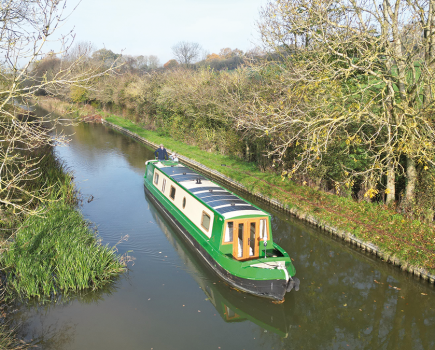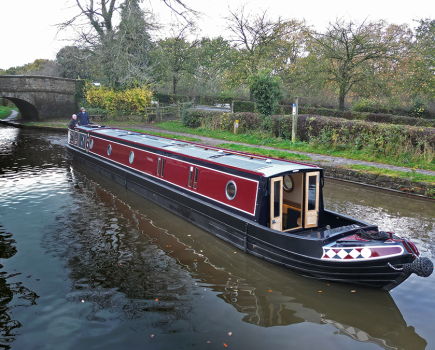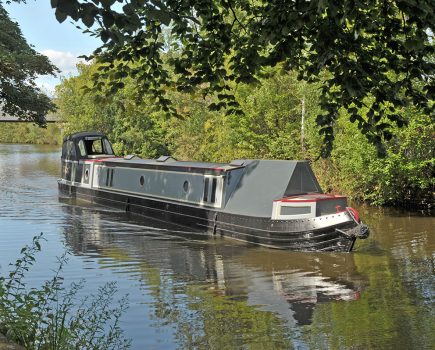As anyone who has had a boat built for them knows, there are hundreds of choices to be made in the process.

As anyone who has had a boat built for them knows, there are hundreds of choices to be made in the process. They range from something as fundamental as how long it is going to be, to details such as the design of the light switches, door handles or taps.
And one of the most crucial choices, which people rightly spend much time over, is who will build it. But for Patricia McLean and Nick Tumber that was one of the easy decisions. They had been hiring for a number of years and knew the company and their boats well, so who better to build their boat. “We’d had a number of excellent hire boat holidays, liked the people and got on really well together,” says Patricia. It was a powerful reason for choosing Clifton Cruisers as their builder.

Although the company is probably best known for its hire fleet, the team there have fitted out their hire boats themselves, so Patricia and Nick knew that their own boat would include plenty of tried and tested features. After all, hire boats have to be bomb-proof, reliable and easy to repair when something does go wrong.
But choosing a hire company to build a private boat doesn’t mean getting a simple no-frills boat: Clifton’s hire boats are far from basic – for example, several have underfloor heating. So Patricia and Nick have ended up with the best of both worlds, a boat full of tried and tested ideas, that’s built to last.

EXTERIOR
From the outside, Bisous is striking because of its simplicity. The Lambon Hull shell has the good solid feel they’re well known for. There aren’t the scrolls and flourishes you find on some hulls, but there are nice little touches all over the place, such as the sturdy grab handles on the forward edge of the cabin side, and a finger-grip along the hand rails. At the stern, there’s a rail around the rear deck.
The bow is a josher style, curvy without being excessively pinched. The well deck has plenty of seating, with storage underneath, to provide a good social area, and it’s illuminated by little LED lights. In the point of the bow there’s a separate fuel tank for a Lockgate stove, which in this case runs on paraffin. A 150-litre water tank sits under the well deck.
Navigation lights have been fitted, positioned mid-way down the cabin side so they’re less vulnerable to being knocked off at bridges. The trim, such as the mushroom vents and the tiller, is chrome, while the Channelglaze double glazed windows and portholes have black frames.
The paintwork was done by a company that normally paints commercial vehicles. It’s sprayed on, then baked in a huge oven to give a very hardwearing finish. The burgundy colour (now christened Clifton Claret) is another striking feature, even more so because of the lack of any kind of coachline or decoration. The sign writing, by Becky Roberts, is equally bold. Bisous is French for ‘kisses’ (Patricia is a French teacher); but with foot-high letters, this isn’t so much a shy peck on the cheek, as a big smacker right on the lips!
LAYOUT AND FITOUT
Bisous has a traditional layout. There’s a saloon at the bow with a built-in dinette, followed by an open-plan galley. Double doors take you into the walk-through shower room, with the cabin beyond, and at the stern, there’s a small utility room. The fitout uses ash-faced ply for the hull room. The fitout uses ash-faced ply for the hull and cabin sides, but all the doors are made from solid ash. The floor is solid oak. All the switches are brushed steel which gives an expensive, classy look.
SALOON AND DINETTE
The saloon has a light, airy, and modern feel, thanks to the pale ash fitout and the large windows. The steps down from the well deck are stylish curved affairs with inset LED lighting, rather than the functional boxes often found. And the curves continue in the units either side of the door.
On one side there’s a full height unit containing two cupboards – designed to house Patricia’s French horn. Phil Little, who’s in charge of the boat-fitting at Clifton Cruisers, has done a fantastic job making the curved doors out of solid planks of ash. Each length had to be planed to exactly the right angle to achieve the correct curve.
On the other side there’s a stylish drinks cabinet. The centrepiece is a slim Coolzone wine cooler and there are shelves for glasses either side. The top is another fine piece of craftsmanship, being made from tapering planks in a fan design. The Lockgate stove is a major feature of the room. It stands on a toughened glass hearth, which adds to the contemporary look of the boat. Equally stylish are the Roman blinds, made in-house at Clifton Cruisers. They’re cleverly kept in place while closed by magnets set into the walls.
The L-shaped dinette has a solid wood table, with an inset glass top. It’s designed for work as well as eating, so there’s a pull-up stack of power points in the corner, as well as an internet point. The table can be taken down and stored under the gunwales when it’s not needed or when the dinette is converted into a double bed for guests.
Over the years, we’ve seen numerous ways of converting dinettes into beds, but this is undoubtedly one of the quickest and easiest. Once the table is out of the way, the doors to the under-seat storage are opened, to double as supports. Then it’s simply a matter of pulling the seat across, while a pulley system lowers the seat back into a horizontal position. Returning the bed to seating is, if anything, even easier: pull a metal cable mounted under the gunwales, and the whole thing looks after itself.
GALLEY
The stylish look continues into the galley, with dark laminate worktops and black glass splashbacks contrasting with all the ash. There’s plenty of light, thanks to a glazed side hatch above the sink, and a large Houdini hatch in the ceiling.
The stainless steel sink is sleek, and a first look at the tap leaves you scratching your head: there appears to be no way to turn it on. Twisting the main body of the tap produces the water. Equipment includes a Philco fridge and Fridgemaster freezer, which are both 12-volt models. There’s a dishwasher and an impressive-looking three-burner gas hob, both from Ikea, and – controversially – an Ikea electric oven, which doubles as a grill and a microwave. Phil Little advised against it, reckoning the engine will need to be running every time it’s used. But Nick Tumber is a physics teacher, and disagrees. “I’ve done the sums,” he says. “I don’t believe it will draw all the power off the batteries.” Either way, the couple were keen to have the combination unit. “If we’d had a gas oven,” says Nick, “we’d have had to have a separate microwave as well, which would have taken up too much space.”
That decision has helped provide plenty of storage space. All the drawers are fitted with soft closers, and the two full height cupboards at the rear have lights that come on automatically when the doors are opened.
SHOWER ROOM
A pair of clever double doors lead from the galley to the shower room. They slide and work on a pulley system so that opening one opens both. At the other side of the room is another sliding door – a single one this time – leading to the cabin. To stop it sliding backwards and forwards while cruising, it’s held open by a long magnet hidden in the edge of the door; a clever idea.
The whole room has a feeling of luxury that starts with the huge shower. In true boutique hotel style, it has a ceiling-mounted storm shower head as well as a hand-held one, and there’s an extractor fan in the ceiling. The white Vitra basin, which has a cupboard another impressive tap – this time a waterfall one. There’s also a striking full-height designer towel rail. The loo is a Jabsco macerator unit, to a remote tank under the bed. The room is lined in Wet Walls, a laminate that won’t crack like tiles. It takes a moment to notice, but there are no gunwales. The laminate stretches from floor to ceiling without a break, adding to the room’s clean lines.
CABIN
The cabin is a relatively straightforward space, dominated by the inline bed. There are cupboards above with sliding doors, and reading lights. In addition to under-bed storage, there’s a large double wardrobe. The hanging rail is illuminated, with the light coming on when the door is opened. Some space in the bottom half is lost, though, to the Alde gas boiler. Like the shower room, there are no gunwales here, either.
UTILITY ROOM
The small utility area at the stern is home to electrical and storage cupboards, and houses a Candy washing machine. It’s a useful area for hanging wet coats, so there’s a finrad to provide extra heat for drying. A set of triangular steps leads up onto the back deck. Their design means that this is a very easy boat to get in and out of.
TECHNICAL
Bisous is powered by a 42hp Canaline engine. These relatively new entrants to the market are based on Korean-built Kioti engines. They’ve been chosen by several large hire fleets, which tells a story about reliability, and are said to fuel-efficient and produce fewer emissions. They have an engine-mounted fuel filter with a built in water trap. And if you ever run out of fuel, there’s a self-priming pump so you won’t spend ages bleeding the system. The engine is teamed with a PRM 150 gearbox and python drive.
One feature Clifton Cruisers has been testing on its hire fleet is an automatic greaser, so you don’t need to remember to turn the stern greaser after mooring up at night. The cartridge in this neat little unit should last for six months, and will tell you when it needs replacing.
Electrical power comes from four 120Ah sealed domestic batteries and there’s also a 95Ah engine battery. For a 240-volt supply a Mastervolt Mass Combi 2.5kw inverter/charger has been fitted which also looks after the charging of the batteries. A shoreline can also be connected. A Blue Sea fuseboard provides read-outs such as how full the batteries are and how much power is being drawn. Lighting is LED throughout, so uses very little power.
We were impressed by how neat and tidy the installation was. The engine bay is so neat, you begin to wonder whether something is missing; and the electrics are all neatly contained in trunking.
Heating is provided by an underfloor system, powered both by an Alde gas boiler and a heat exchanger which gives ‘free’ heat from the engine while cruising. The underfloor system doesn’t take up as much room as you might think, so (contrary to popular belief) headroom is hardly affected. On top of the normal ballast there’s a 45mm thick layer of polystyrene, which comes with grooves already cut into it. Then comes a thin metal sheet, also with grooves, which is designed to reflect the heat upwards. Special hard-wearing pipes then fit into the grooves, before normal floorboards are laid on top, plus whatever flooring you want. In this boat, there are two flooring you want. In this boat, there are two separate heating loops which can be independently controlled, one for the bedroom and shower room, the other for the galley and saloon. Each consists of about 40 metres of pipes with no joins.
The system has been tried and tested as it’s fitted on several of Clifton Cruisers hire boats. The first one has been running for nearly three years, or more than 5,000 cruising hours, with no problems. Unlike stoves and radiators, underfloor heating provides all-over heat, with no hot or cold spots.
The plumbing system is also unusual (and that’s not a sentence I ever thought I’d write). Rather than a hot and cold ring main running around the boat with branches off feeding the taps and the shower, in this boat each outlet has its own independent supply. A manifold is located under the rear steps and each pipe is individually labelled and controllable – red ones for hot water, white ones for cold. It means that there are far more water pipes running down the side of the boat than you’d normally get, but Phil Little says there are distinct advantages. First, the pipes are flexible enough to go around corners without any joints, so leaks will only ever occur at the manifold or at the outlet. Second, if anything does go wrong, with the shower for example, it can be turned off independently without affecting the water supply to the loo or the galley.
ON THE WATER
Bisous performed well while underway. The hull moves nicely through the water, and the steering is fine. The whole boat has a pleasing solidity about it from the helm. There are no bow thrusters, but we managed to turn without any trouble, in spite of the best efforts of a fierce wind. The Canaline engine responded well, and was quiet enough. It will soon be quieter still, when sound insulation has been installed under the deckboards.
CONCLUSION
With a list of features including underfloor heating, a luxury bathroom and a smart galley, you’re probably expecting the price of this boat to be well into six figures. But you’d be wrong: a boat like this will set you back £93,000, which in today’s market is excellent value for money. If we have a criticism, it’s that the finish and detailing on some of the woodwork isn’t of quite the quality you’d find on more expensive boats. But, that said, we were impressed with the number of ideas and clever solutions crammed into this boat.
Patricia and Nick say they are thrilled with the finished result and are looking forward to their retirement when they can spend several months a year cruising. They’ve made their choices, hundreds of them, and are certain they got them right.







